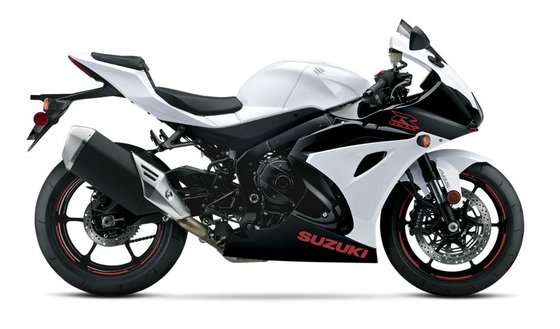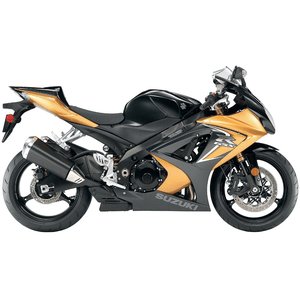Suzuki GSX-R 1000 [2017 - 2021] Review: The King Reimagined

Since its debut in 1985, the Suzuki GSX-R series has redefined sportbike performance. The 2017–2021 GSX-R 1000 iteration represents a quantum leap in engineering, blending MotoGP-derived tech with street-riding practicality. As a machine designed to "Own the Racetrack," this generation of the GSX-R 1000 isn’t just about raw power—it’s about precision, adaptability, and a rider-first philosophy. Let’s dissect what makes this liter-class legend tick and why it still resonates with riders today.
The Heart of a Champion: Engine & Performance
Power Delivery: A Symphony of Brutality and Control
At its core lies a 999.8cc inline-four engine, a masterpiece of modern engineering. With 198.5 HP (199.2 hp in some markets) at 13,200 RPM and 117.6 Nm (86.7 lb-ft) of torque, this engine is a study in controlled aggression. The secret sauce? Suzuki’s Variable Valve Timing (SR-VVT), which optimizes valve timing for explosive top-end power without sacrificing mid-range punch.
- Ride-by-Wire Throttle: Delivers razor-sharp response, whether you’re feathering the grip in traffic or pinning it on a straightaway.
- Suzuki Top Feed Injectors (S-TFI): Dual injectors per cylinder ensure flawless combustion, even at redline.
- SET-Alpha Exhaust Tuning: The 4-2-1 titanium exhaust isn’t just for show—its tunable valves minimize backpressure, letting the engine scream while staying Euro-compliant.
On the Road/Track: Cracking the throttle open feels like unleashing a caged animal. Below 8,000 RPM, the bike pulls hard but predictably. Past 10,000 RPM? Hold on. The front wheel skims the pavement, and the howl from the intake ducts and exhaust becomes addicting. This isn’t just speed—it’s velocity with purpose.
Chassis & Handling: Surgical Precision
Frame Geometry: Born in the Wind Tunnel
The aluminum twin-spar frame is 10% lighter than its predecessor, with a 6-degree rearward engine tilt shortening the wheelbase to 1,420–1,485 mm (55.9–58.5 in). Paired with a braced swingarm, the setup offers telepathic feedback—you feel every ripple in the asphalt but never lose composure.
- Showa Balance Free Front Forks: 43mm inverted units with external damping chambers. Adjustable for high/low-speed compression, they eat curbs for breakfast.
- Rear Suspension: A Showa shock with remote reservoir and linkage system keeps the rear planted under hard acceleration.
Cornering Dynamics: Flicking the GSX-R through hairpins is effortless. The narrow profile (just 705 mm/27.8 in wide) lets you dive into apexes like a hawk striking prey. Even at full lean, the Bridgestone RS11 tires inspire confidence, gripping like velcro.
Electronics Suite: MotoGP Tech for Mortals
IMU-Driven Wizardry
The six-axis Inertial Measurement Unit (IMU) is the brain behind the brawn:
- Motion Track Traction Control: 10 modes adjust slip levels, from "rain-safe" to "track-day hero."
- Bi-Directional Quick Shifter: Clutchless up/downshifts are buttery smooth, even when redlining.
- Motion Track ABS: Unlike basic systems, this IMU-guided ABS modulates front brake pressure to prevent rear-wheel lift under panic braking.
Real-World Use: In Mode 2 (Intermediate), the electronics are invisible—until you hit a greasy patch mid-corner. Then, the subtle intervention feels like a guardian angel nudging you back online.
Design & Ergonomics: Form Meets Function
Aerodynamics: Slippery When Aggressive
The fairing isn’t just pretty—it’s wind-tunnel honed. Dual Suzuki Ram Air Direct (SRAD) ducts funnel air into the intake, adding a 3-5 HP boost at speed. The LED headlights? They’re 30% lighter than conventional units and pierce night rides with icy clarity.
Rider Triangle: At 825 mm (32.5 in), the seat is lower than rivals like the R1, making it accessible for shorter riders. The clip-ons are aggressively positioned, but the tank’s slim profile lets you tuck effortlessly. After an hour in the saddle, your wrists will complain—this is a track tool at heart.
Competition: How Does It Stack Up?
Yamaha YZF-R1
- Strengths: Crossplane crankshaft for V8-like torque, more adjustable electronics.
- Weaknesses: Harsher low-speed ride, pricier maintenance.
- GSX-R Edge: The Suzuki’s IMU system feels more intuitive, and the chassis is friendlier for street use.
Honda CBR1000RR-R Fireblade
- Strengths: 214 HP, aerospace-grade materials.
- Weaknesses: Overkill for public roads, numb throttle response below 6,000 RPM.
- GSX-R Edge: The Honda’s a rocketship, but the GSX-R’s balance of power and poise makes it a better daily companion.
Kawasaki Ninja ZX-10R
- Strengths: Supercharged variants, robust aftermarket.
- Weaknesses: Heavier (207 kg vs. Suzuki’s 202 kg), complex electronics.
- GSX-R Edge: Kawasaki’s tech dazzles, but the Suzuki’s analog thrill is irreplaceable.
Maintenance: Keeping the Beast Alive
Key Considerations:
- Oil Changes: Every 6,000 km (3,700 mi) with 10W-40 synthetic. The wet sump system is simpler than rivals’ dry setups but demands consistency.
- Valve Checks: Every 24,000 km (15,000 mi). Titanium valves stay in spec longer than steel, but don’t skip inspections.
- Chain & Sprockets: The DID 525 chain lasts 15,000+ km with regular cleaning. Upgrade to a Vortex aluminum sprocket kit for weight savings.
MOTOPARTS.store Upgrades:
- Steel-Braided Brake Lines: Fix the stock rubber hoses’ mushiness.
- Aftermarket Exhaust: A full Akrapovič system sheds 5 kg and unlocks hidden top-end fury.
- Suspension Tuning Kits: Öhlins cartridges transform the Showa forks into track-ready weapons.
Final Verdict
The 2017–2021 GSX-R 1000 isn’t just a motorcycle—it’s a statement. Suzuki took MotoGP tech, distilled it into a street-legal package, and somehow made it feel alive. While rivals chase horsepower wars or electronic gimmicks, the GSX-R remains rooted in the pure joy of riding. It’s a machine that demands respect but rewards with unadulterated thrills. Whether you’re carving canyons or hunting apexes, this generation proves the "King of Sportbikes" crown still fits.
Ready to elevate your GSX-R? Explore our curated selection of performance parts at MOTOPARTS.store—where legends are reborn.
Specifications sheet
| Engine | |
|---|---|
| Stroke: | Four-stroke |
| Max power: | 149 kW | 200.0 hp |
| Max torque: | 118 Nm |
| Fuel system: | Fuel Injection with Ride-by-Wire Throttle Bodies |
| Max power @: | 13200 rpm |
| Displacement: | 998 ccm |
| Max torque @: | 10800 rpm |
| Configuration: | Inline |
| Cooling system: | Liquid |
| Exhaust system: | 4-2-1 with titanium muffler and SET valve |
| Compression ratio: | 13.2:1 |
| Lubrication system: | Wet sump |
| Number of cylinders: | 4 |
| Valves per cylinder: | 4 |
| Dimensions | |
|---|---|
| Wheelbase: | 1404 mm (55.3 in) |
| Wet weight: | 202 |
| Seat height: | 825 mm (32.5 in) |
| Overall width: | 705 mm (27.8 in) |
| Overall height: | 1145 mm (45.1 in) |
| Overall length: | 2075 mm (81.7 in) |
| Ground clearance: | 130 mm (5.1 in) |
| Fuel tank capacity: | 16 L (4.23 US gal) |
| Drivetrain | |
|---|---|
| Clutch: | Wet multi-plate with Suzuki Clutch Assist System (SCAS) |
| Final drive: | chain |
| Chain length: | 120 |
| Transmission: | 6-speed constant mesh |
| Rear sprocket: | 45 |
| Front sprocket: | 17 |
| Maintenance | |
|---|---|
| Engine oil: | 10W40 |
| Brake fluid: | DOT 4 |
| Spark plugs: | NGK CR9EIA-9 |
| Spark plug gap: | 0.8 |
| Coolant capacity: | 2.5 |
| Forks oil capacity: | 1.2 |
| Engine oil capacity: | 3.3 |
| Engine oil change interval: | Every 5000 km or 2 years, whichever comes first |
| Valve clearance (intake, cold): | 0.10–0.20 mm |
| Valve clearance check interval: | 24,000 km / 15,000 mi |
| Valve clearance (exhaust, cold): | 0.20–0.30 mm |
| Recommended tire pressure (rear): | 2.9 bar (42 psi) |
| Recommended tire pressure (front): | 2.5 bar (36 psi) |
| Additional Features | |
|---|---|
| Lighting: | LED headlight and taillight |
| Electronics: | Inertial Measurement Unit (IMU), Suzuki Drive Mode Selector (S-DMS), Motion Track Traction Control (MT-TCS) |
| Instrumentation: | LCD multi-function panel with lap timer and gear indicator |
| Chassis and Suspension | |
|---|---|
| Rake: | 23.2° |
| Frame: | Aluminum twin-spar |
| Trail: | 94 mm (3.7 in) |
| Rear tire: | 190/55z-17 |
| Front tire: | 120/70z-17 |
| Rear brakes: | Single 220 mm disc, Nissin 1-piston caliper (ABS) |
| Front brakes: | Dual 320 mm discs, Brembo 4-piston radial calipers (ABS) |
| Rear suspension: | Showa link-type monoshock, fully adjustable |
| Front suspension: | Showa Big Piston Fork (BPF), inverted telescopic, fully adjustable |
| Rear wheel travel: | 130 mm (5.1 in) |
| Front wheel travel: | 125 mm (4.9 in) |



















